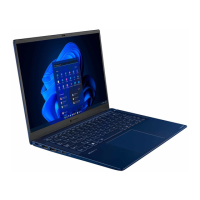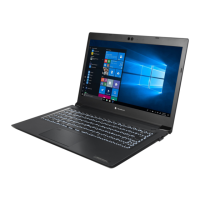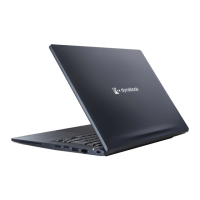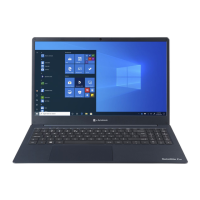
Do you have a question about the dynabook PORTEGE X30W-J and is the answer not in the manual?
| Graphics | Intel Iris Xe Graphics |
|---|---|
| Bluetooth | Bluetooth 5.1 |
| Processor | Intel Core i7-1165G7 |
| RAM | 16 GB |
| Storage | 512 GB SSD |
| Display | 13.3 inch FHD (1920 x 1080) IPS |
| Operating System | Windows 10 Pro or Windows 11 Pro |
| Battery | 4-cell Lithium-ion |
| Ports | HDMI, Headphone/Mic |
| Wireless | Intel Wi-Fi 6 AX201 (802.11ax) |
Details on regulations and compliance applicable to the device.
FCC RF exposure compliance and EU Declaration of Conformity.
Guidelines for proper disposal and compliance with chemical regulations.
List of included items and explanation of manual conventions.
Instructions on how to connect the AC adaptor for power and charging.
Steps for powering on the computer, initial setup, and Windows navigation.
Explains how to use Sleep and Hibernation modes to save power and work.
Information on creating and using recovery media or partitions for system restoration.
Identifies major external components of the computer on the front, sides, back, and underside.
Information on keyboard layout, special keys, fingerprint sensor, and touch pad functions.
Describes internal components like CPU and Storage, and explains power indicators.
Guidelines and precautions for using the computer in tablet mode.
How to use touch screen gestures and operate the stylus pen.
Details on keyboard layout, function keys, and using the fingerprint sensor for login.
Information on battery types, usage, charging methods, and monitoring capacity.
How to use memory media, HDMI, USB-C, and LAN ports for connectivity.
How to configure system settings using the dynabook Settings utility for various functions.
Using eco mode for power saving and USB charging features like Power Off and Charge.
Setting up passwords for security and using maintenance utilities like dynabook Maintenance Utility.
Description of unique or advanced features like automatic power off, sleep/hibernation modes, and USB Wake-up.
Guidelines for identifying and resolving computer problems effectively using a systematic approach.
Steps to analyze and resolve issues related to software, hardware, indicators, and sounds.
Troubleshooting steps for common problems with power, keyboard, display, storage, and connectivity.
Solutions for issues with fingerprint sensor, USB devices, sound systems, and wireless connectivity.
Guidance on how and when to contact technical support for assistance with unresolved issues.
Summary of physical, environmental, and power requirements for the computer.
Details on wireless technology, regulatory compliance, and regional restrictions.
How to customize Windows settings for vision, hearing, and interaction accessibility needs.
Factors affecting CPU performance and battery life, and characteristics of LCD screens.











